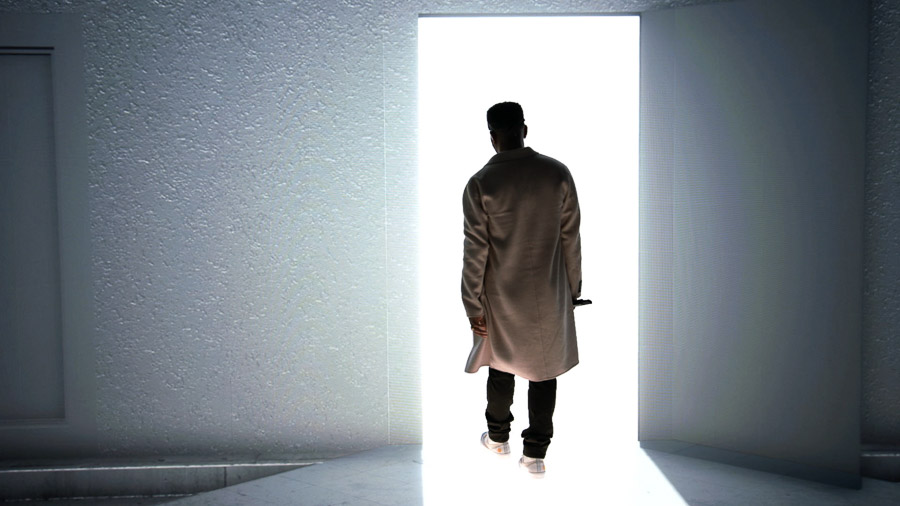
Xite Labs – founded in 2018 by visual and production design specialists Greg Russell and Vello Virkhaus – was approached by director Mike Carson and The 92 Group to assist in the production of stunning XR environments for Talented trapsoul singer, rapper, and songwriter Bryson Tiller who recently recorded an XR concert for later broadcast in Calabasas, California at Xite Labs’ XR stage facility.

Xite received a detailed brief with a set of storyboard images and a flow concept of the four dynamic worlds that they wanted to build.
The 3D spaces were created by multiple highly skilled artists using Unreal Engine and Notch.
For the shoot, the physical studio design comprised three-sides including a back wall of LED, an LED floor with rear lights at high angles following the back wall curve, plus several front and side filler lights.
Two cameras were involved, one mounted on a tripod and one on the end of a human-operated 12ft arm crane. The crane camera was fitted with a Canon 18-105 lens, and a stYpe Red Spy optical camera tracking system, the combination of which enabled a wide range of motion and looks.
The secondary camera had a long lens and was offset to the left of the main LED screen and used for a range of classic static telephoto looks.

To support and complement any sort of XR / AR performance, it is crucial that lighting is fully aligned with the environments which exist only in the background to avoid the subject looking ‘shopped’ on camera.
“In XR / ER / AR, etc. lighting has to provide all the ambient light and the many related subtleties from the environment that would normally affect a subject,” explained Vello, so it must be super precise and very carefully thought-through.
On this occasion, the Robe Tetra2s were used for side fills, the T1 Profiles and BMFL Blades were rigged in the front and high side lighting positions, while the SuperSpikies were at the back.
All of these provided light on Tiller that closely mirrored the activity of the richly contrasting environments which included shadows from trees or pulsing lights from glowing mushrooms bursting with color and other elaborate fantasy plant life, to vast open spaces with dramatic stark minimal blocks of color and texture.
“All these needed lighting applied that reflected on the artist and created that fully immersive look,” stated Vello. Over the pandemic, T1 Profiles have become a favorite for XR and AR video shoots for several reasons, and Vello confirms this.

He cites the great CRI and accurate framing shutters for the T1, the latter essential to accurately eliminate any light spill onto the LED screens, plus a good set of gobos and the ability to reproduce environmental color changes instantly via the Multi-Spectral LED (MSLTM) light engines, an attribute that runs much slower with white source fixtures.
He loves the prism and gobos effects of the SuperSpikie and in this instance the fixtures could also create background variants with their immediate color changing and “good hybrid-like feature set.”
While initially thinking that the Tetra2 multiple zoom zones might be “a bit much”, things soon changed when Vello and Greg had these in the studio and this same feature turned out to be super useful in getting both a varied foreground ‘hotspot’ and fill effects from the same lighting unit! “A lot of variation and power for a batten / strip light.”
The BMFL Blades were brought in as an extra by DoP Russ Fraser and used to side light the artist and create patterns and light movement.
A grandMA2 system was used for control, with lighting and video cues timecoded for perfect synchronicity between the creative and narrative events.

The biggest challenge was creating long-form narrative worlds that would transform seamlessly from one song to the next through complex spatial, geometric and lighting sequences and “drilling more deeply into the cinematic aspects of Extended Reality”. A total of 14 songs were recorded.
Lighting equipment was supplied by Russ Fraser Films and the production company was HPLA with Bryson Tiller, Ryan Hahn, and Neil Dominique as executive producers. Mike Carson was the show director, and the overall creative direction was a collaboration between Vello Virkhaus and Greg Russel, Amish Dani, and Sam Ashcroft.
Lighting director was Mike Robertson from Lightswitch who also did the timecode pre-programming and show file setup, and the d3 server operator was Simon Anaya.

Xite Labs frequently use Robe in their work. “The combination of versatility and high light output is much appreciated,” commented Vello, adding that some Robe products have absolutely “ideal” feature sets to complement virtual productions and other projects and especially the “radically diverse” array of work being produced at Xite Labs!
They and production partner company Lightswitch have been using Robe for many years and they keep returning to the brand for their “notably quality products”.
For more product and general info about Robe and their products, you can check www.robe.cz







